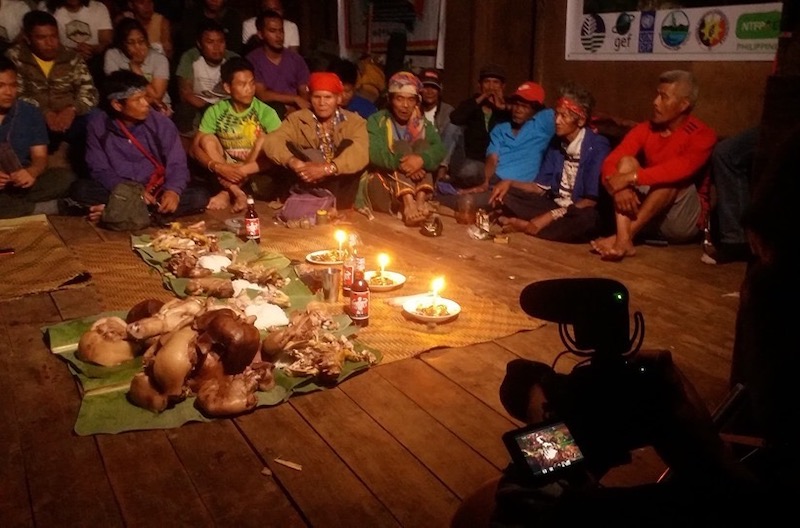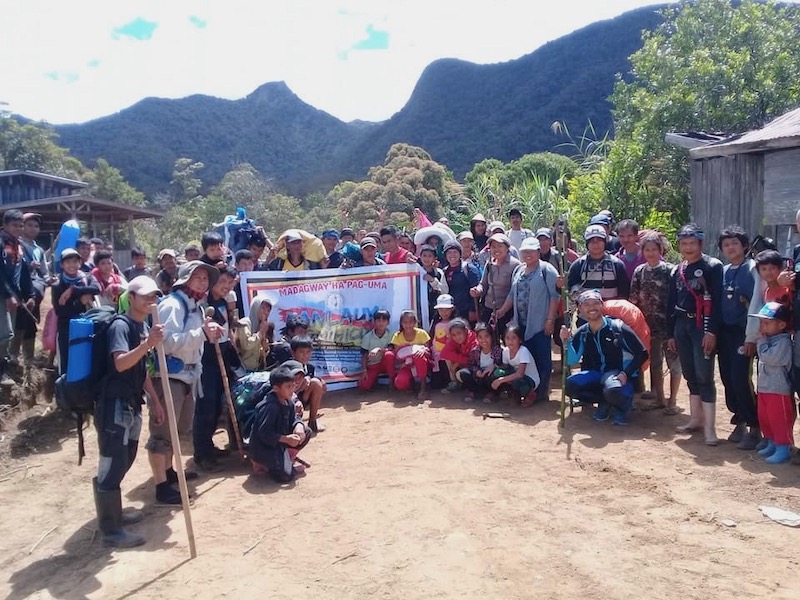Last of two parts
CAGAYAN DE ORO CITY (MindaNews / 29 July) — Etymologically, religion is derived from Latin re-ligar which literally means “re-link.” In this sense, religion may be seen as a way to re-link us to the Creator, the Source of our being. However, religion’s role cannot just be limited to ritual, worship, doctrine and other forms of expressing our link with the divine. It also offers an ecological understanding about the world to indicate a particular way of re-linking with the divine.[1] Thus, religious worldviews, including ancestral knowledge of the natural world, have their proper place in integral ecology.

The Indigenous Ecological Worldview
Aside from reading books[2], conversing with the Lumads who served as our guide during the mountain climbing activities has been a privileged moment for me to know more about their ecological worldview. In fact, they did not just show us the way to the forest; they actually taught us how to survive in the jungle and to meaningfully commune with nature. Thus, I consider listening to the raw explanations of the Lumads as truly an epistemological advantage to supply the missing elements that cannot be found in books.
To begin with, I have a lasting impression that the indigenous ecological worldview is essentially animistic. The Lumads of Mindanao, for instance, believe in Magbabaya, the inaccessible supreme deity who created everything. To make his divine presence accessible to human beings, there are environmental spirits or lesser deities who dwell in particular places such as rivers, plants, caves, mountains, trees, and certain animals. Recognizing their sacred presence nurtures the Lumad’s deep love for nature.
For the IPs, the natural world is the dwelling place of environmental spirits and other enchanted beings which have the capacity to influence people’s lives. They perceive nature as full of spirits and, thus, capable of engaging reciprocal relationships with humans. Such a worldview moves the IPs to sacralize the whole of the natural world.
Conscious of the sacred presence of the environmental spirits, IPs respectfully observe certain designated spaces and times in nature. For instance, they will not do anything inside the forest without first asking permission ritually from the spirits that dwell therein. They believe that people share their physical environment with the non-human dwellers of the supernatural world.
It must be noted that IPs do not just look at nature as the common dwelling place of both humans and non-humans. They actually consider their lives as deeply interwoven in the very fabric of nature. In the profound words of a Talaandig Datu Migketay (real name: Victorino Saway): “the earth is our flesh, the water is our blood, the trees are our bones, the vines are our veins, the sun is our torch and sight, the air is our breath and strength, the sound is our language, the cosmic energy and the spirits are our soul.”[3] This mystical experience of being one with nature makes the Lumads realize that ecological destruction of nature is tantamount to self-destruction.

What Can We Learn from the Indigenous Ecological Worldview?
The ecological perspectives of IPs arguably remain very relevant today despite current advances in ecological sciences. Let me highlight here the extremely high value they give to their ancestral land—the land of their birth where their ancestors grew up, raised their families, and were buried. For the Tiruray, for instance, the ancestral land is sacred because they believe that this is the place “where the spirits of their ancestors roam [and] … help them take care of the land.”[4] The spirit guides those that dwell in this land, which is not simply the soil but includes all the natural resources, the bodies of water, the airspace, minerals under the Earth.
The IPs make sure that the land ecosystem is healthy and well-functioning. They know that people would not survive in a land “where no birds soar, a barren land where no trees, flowers, and crops grow, where no beasts run free. What use has a piece of land when it cannot feed several generations of its people?”[5] A depleted environment, therefore, destroys the indigenous cultures and humanity of its inhabitants.
St. John Paul II was the first Pope to officially recognize the intimate connection between IPs and their ancestral land. It was clear to him that when “indigenous peoples are deprived of their land, they lose a vital element of their way of life and actually run the risk of disappearing as a people.”[6] IPs identify themselves with the ancestral land so intimately that separation from it would naturally lead to the destruction of their culture and eventually to their extinction. As such, John Paul II rightly links tribal peoples’ land rights with the right to life.
Building on his predecessor, Pope Francis also speaks of the “cultural ecology” of IPs to counteract the unsustainable practices of the modern societies. He wants us to learn from IPs who treat land not as commodity but as “a gift from God and from their ancestors who rest there, a sacred space with which they need to interact if they are to maintain their identity and values.”[7] He laments that the global trend of modern cultures forces IPs “to abandon their homelands to make room for agricultural or mining projects which are undertaken without regard for the degradation of nature and culture.”[8] A concrete way to defend IPs, therefore, is to join them in their struggle for agrarian justice and help them cope with the negative effects of modern cultures.
[MindaViews is the opinion section of MindaNews. Reynaldo D. Raluto is a Roman Catholic priest of the Diocese of Malaybalay. He is the Academic Dean of St. John Vianney Theological Seminary in Cagayan de Oro where he also teaches fundamental/systematic theology and Catholic social teaching. He is the author of Poverty and Ecology at the Crossroads: An Ecological Theology of Liberation in the Philippine Context (Quezon City: Ateneo de Manila University Press, 2015). His ecological advocacy includes planting/growing Philippine native trees, mountain climbing, and defending the rights of Indigenous Peoples.]
READ:
INTEGRAL ECOLOGY: A liberative approach to the evangelization of indigenous cultures
[1] For a fuller treatment of this view, see Leonardo Boff, Ecology and Liberation: A New Paradigm (Maryknoll, New York: Orbis Books, 1995), 55-61.
[2] Those who seek to deepen their IP advocacy may find the following works of Filipino anthropologists very helpful: Francisco Claver, “The Social Marginalization of Tribal Peoples and Their Contribution to Ecological Health,” in FABC Paper, No. 80 (1995); available from http://www.ucanews.com/html/fabc-papers/fabc-80.htm (date accessed: September 14, 2009); Karl M. Gaspar, Manobo Dreams in Arakan: A People’s Struggle to Keep Their Homeland (Quezon City: Ateneo de Manila University Press, 2011); and Albert Alejo, Generating Energies in Mount Apo: Cultural Politics in a Contested Environment (Quezon City: Ateneo de Manila University Press, 2000).
[3] Quoted in the power point presentation of Albert Alejo, “Pakigduyog sa mga Lumad: Identity and Solidarity of Indigenous Peoples in Mindanao,” (Theological Forum at St. John Vianney Theological Seminary, September 27, 2012).
[4] Stuart Schegel, Tiruray Subsistence (Quezon City: Ateneo de Manila University Press, 1979), 135.
[5] Quoted in TRICOM, SNV, ICCO and AFRIM, Defending the Land: Lumad and Moro Peoples’ Struggle for Ancestral Domain in Mindanao (Davao City: AFRIM, 1998), 8-9.
[6] John Paul II, “To Build Peace, Respect Minorities: World Day of Peace Message,” December 8, 1988, Origins 18 (1988), 466-469, on 468.
[7] Pope Francis, Laudato Si’: On Care for Our Common Home (May 24, 2015), no. 146.
[8] Francis, Laudato Si’, no. 146.







